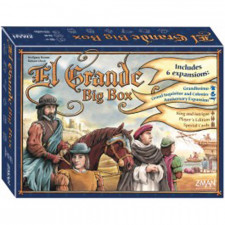El Grande: Big Box Review
on Feb 10, 2016
Some claim El Grande hasn’t aged well, and they’re right in a sense. The game certainly wouldn’t fit in with a class picture of 2016 game designs in any event. Richard Ulrich and Wolfgang Kramer’s classic area majority game features tension, brutal conflict, and a seemingly bottomless well of replayability, most of which are lacking in the modern Eurogame movement that El Grande itself helped spawn. But if El Grande is considered old school, I don’t want to get with the times anyway.
Many modern designers pride themselves on creating elegant interlocking mechanisms that all work smoothly as a single whole. El Grande by way of contrast feels almost clunky. There’s bidding for turn order, selecting action cards, and a whole host of exceptions and nuances that drive the whole thing forward. What’s more, you’ve got to work together to bash the leader, a brute-force balancing mechanism that’s frowned upon nowadays. In fact, managing your position on the score track is essential to good play. If you’re way out ahead of everyone too soon, the rest of the game can be painful as players target you with every action and caballero placement. So you need to surmise and manage the other players’ intentions along with the mechanisms humming along on the board in front of you.
Not that Kramer’s design doesn’t pack enough punch on its own, mind you. There are many dimensions to consider every turn, like a minigame of supply chain management, point generation through area majorities, and picking your moments to bid high for valuable action cards. In a day when many games sprinkle points like breadcrumbs in front of the players, El Grande competitors will lurch along the score track like drunk drivers, getting smatterings of points and then suddenly making a massive play for a few dozen at once. It’s a charming, uneven tempo, and far more exciting than slowly generating points here and there.
Add all these pieces together, and it’s a good game, but not more remarkable than any of the hundreds of light-to-medium Eurogames released over the past couple decades. No, what really pushes El Grande over the top are the peculiar mechanisms of the King and the Castillo. The King forces players to get creative with their meeple placements, as his region is forbidden and players can usually only place adjacent to his towering figure. What this means is players will viciously compete for control and movement of the King, tugging him to and fro both in order to render their opponents’ most lucrative regions vulnerable and in order to secure their on.
The other game piece looming over medieval Spain, The Castillo, truly makes the game sing. It prevents the relatively simple area control element from becoming flatly deterministic, and forces players to consider the other people sitting around the table. Players can forgo dropping meeples into valuable spots on the board and instead dump them into the Castillo, which represents sending caballeros off to war, or something. Then when these knights return home during each scoring round, players simultaneously and secretly select a region into which to dump them. Good use of these “paratroopers†can turn a scoring round on its head as players swipe away massive bonuses from their opponents, or bluff well and make them dump meeples into a less than optimal space. It’s big, daring game design that generates bold, risky plays.
I recently introduced El Grande to some non-gamers. I saw their eyes glaze over as I rattled off the rules, explained the importance of the bidding round and action cards, and tried to set them in the right strategic direction. See, the game is a little bit clunky on paper, as the interaction among the different phases isn’t quite apparent at first, and both strategy and tactics don’t seem intuitive. I was afraid I had lost them as I waxed eloquent on the importance of moving the King and hedging your bets in the depths of the Castillo. Yet just an hour later as the final scoring round closed in, you wouldn’t have been able to tell we weren’t playing a heated game of Risk from all the hooting and hollering around the table.
Ultimately, the game isn’t about the bidding or a clever action card play. It’s about the people sitting next to you. It’s a game wherein you’ll whine, extort, threaten, and cajole your fellow players so that when the dust settles, your nose is just a little less bloody than everyone else’s. It’s violently competitive and interactive in all the right ways, so it’s definitely out of step with much of modern game design. And it’s better for it.
My only real complaint with the product is the way Z-Man elected to re-release it. Rather than unleash an everyman’s edition that fits nicely on the shelf, they’ve gone all-out with a superfluous Big Box package. There are several expansions in the release, and it’s very well produced, but ultimately they’re all unnecessary. El Grande was just about perfect upon release, so it’s strange that a regular edition wasn’t reprinted alongside the bigger, more expensive monstrosity.
But it’s still well worth having, even if it’s close to the size of an old FFG coffin box. Whether you want to get schooled in classic game design or you just want to school your friends, El Grande is one that will challenge your idea of just how innovative a classic design can be.

 Customer Support
Customer Support  Subscribe
Subscribe 




 Account
Account  Wishlist
Wishlist 

